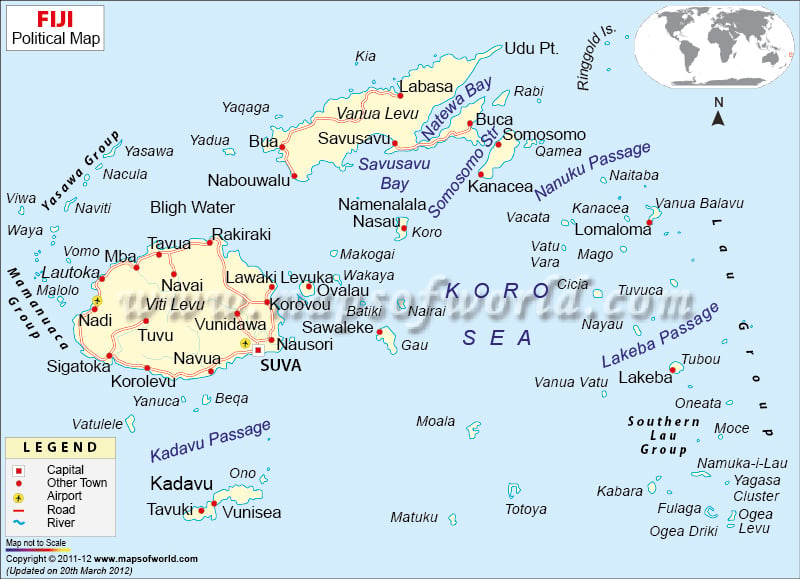- Continent And Regions - Oceania Map
- Other Fiji Maps - Fiji Map, Where is Fiji, Fiji Blank Map, Fiji Road Map, Fiji Rail Map, Fiji River Map, Fiji Cities Map, Fiji Physical Map, Fiji Flag
The Republic of Fiji is an island nation in Melanesia in the South Pacific Ocean. The estimated population of the country is 849,000 and covers a total area of 7,056 square miles.
As shown in the Fiji Political Map, the island nation’s closest neighbors are Vanuatu to the west, France’s New Caledonia to the southwest, New Zealand’s Kermadec to the southeast, Tonga to the east, the Samoas, France’s Wallis and Futuna to the northeast and Tuvalu to the north.
The Republic of Fiji is composed of 322 islands. Viti Levu and Vanua Levu are the two major islands.
The political map of Fiji shows the national capital, major cities and towns, airports, and the neighboring countries and other islands.
Suva is the capital of Fiji and is located on the southeast coast of the island of Viti Levu. Almost half of the population resides in Suva. It has an area of 790.5 square miles and an estimated population of 85,691. On the map, it is marked with a red square enclosed in a square.
For administrative purposes, Fiji is divided into four major divisions that are further divided into fourteen provinces. The fourteen provinces are:
|
|
The other major towns and cities as shown in the Fiji Political Map are: Tavuki, Lautoka, Nadi, Sigatoka, Lomaloma, Kanacea, Vunidawa, Sawaleke, Somosomo, and Lakeba.
The governance of Fiji takes place in the framework of a military appointed government and a Parliamentary Republic. The President is the head of state while the Prime Minister functions as the head of government. The current President is Epeli Nailatikau and the Prime Minister of the nation is Frank Bainimarama.
Fiji experienced a period of rapid growth in 1960s and 1970s which stagnated in the 1980s. Urbanization and expansion in service sector has contributed to the GDP growth. Sugar export and the tourism industry are major sources of foreign exchange.
| Division | Population: 2007-08-16 census. | Area(km.²) | Area(mi.²) | Capital |
|---|---|---|---|---|
| Central | 342,386 | 4,293 | 1,658 | Suva |
| Eastern | 37,311 | 1,376 | 531 | Levuka |
| Northern | 135,961 | 6,199 | 2,393 | Lambasa |
| Rotuma | 2,002 | 46 | 18 | Motusa |
| Western | 319,611 | 6,360 | 2,456 | Lautoka |
| 5 divisions | 837,271 | 18,274 | 7,056 |

 Fiji History
Fiji History